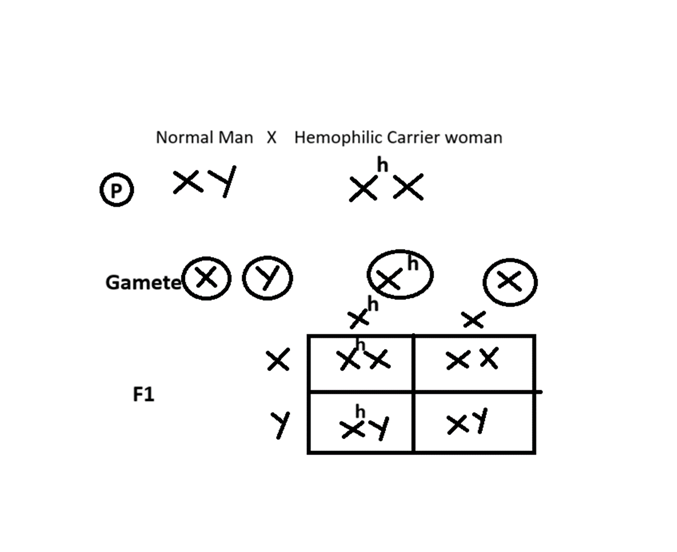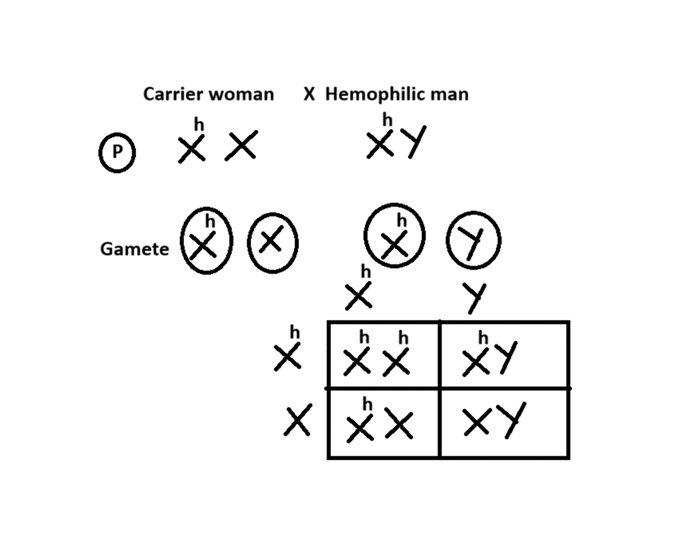- What is hemophilia? Explain the following conditions of hemophilia:
- a) A normal man marries a hemophilia carrier woman. What would be the percentage of carrier daughters and affected sons that could be born to this couple?
- b) What would happen to the next generation of a carrier woman marries an affected man?
- c) What is such a pattern of inheritance called?
What is Hemophilia?
Hemophilia (philia = love; hemo = blood) is a sex-linked recessive genetic disorder that occurs due to a mutation in the gene responsible for the coding of one of the blood clotting factors. Blood coagulation is a multi-step pathway and requires several clotting factors for the conversion of soluble fibrinogen to insoluble fibrin that plugs the site of injury and eventually the bleeding stops. In the absence of one of the factors in the blood clotting cascade pathway, blood does not coagulate. In other words, a small cut in the body results in continuous bleeding. And, that’s the reason why hemophilia is otherwise called as the bleeder’s disease.
Types of Hemophilia
Hemophilia is broadly classified into two types based on the affected blood clotting factor. The two types are mentioned below:
- Hemophilia A: this is caused by the mutation in the gene responsible for encoding the blood clotting factor protein VIII (anti-hemophilic globulin). About 85 percent of people with hemophilia fall into this category.
- Hemophilia B: this is caused by the mutation in the gene responsible for encoding the blood clotting factor protein IX (plasma thromboplastin). Hemophilia B is also known as Christmas disease because it was first reported in a 5-year-old boy named Stephen Christmas in 1952.
The defective recessive sex-linked gene, ‘h’, is present on the X-chromosome. If both the X-chromosomes carry the defective gene, then the female becomes hemophilic (XhXh). This defective gene combination is lethal in nature, and thus the females usually die before birth. On the other hand, if a female contains only a single allele of the defective gene, they are called carriers and appear normal (XhX). In case of males, since the Y-chromosome does not carry any defective allele ‘h’ – the presence of a single defective allele can cause the disease (XhY). Hemophilic male needs regular blood transfusion to live a normal life.
a) A normal man marries a hemophilia carrier woman. What would be the percentage of carrier daughters and affected sons that could be born to this couple?

Inference: If a normal man marries a hemophilic carrier woman and if they have 4 kids, one daughter will have one normal daughter and the other carrier daughter. On the other hand, out of two sons, one would be a normal son and the other one would be hemophilic. In other words, the carrier daughter and affected son would be 25% each.
b) What would happen to the next generation of a carrier woman marries an affected man?

Inference: If a carrier woman marries a hemophilic man and if they have four kids based on the gametes and crosses, one daughter would be hemophilic and one would be a carrier. On the other hand, one son would be hemophilic and one would be a normal son.
c) What is such a pattern of inheritance called?
The pattern of inheritance is criss-cross because mother always inherit the trait to her son and the father always inherit to the daughter.
